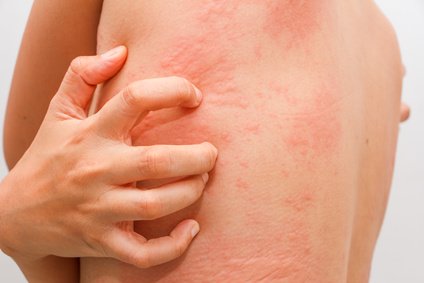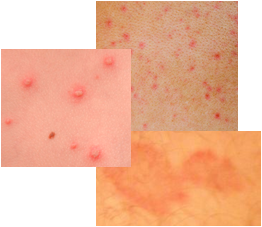- Home
- Rash Diagnosis
- Itchy Raised Lines on Skin
Itchy Raised Lines on Skin
Visit this
PICTURES OF RASHES PAGE
Itchy raised lines on skin can be a perplexing and often uncomfortable condition affecting many individuals around the world. This phenomenon, while often benign, can cause significant discomfort and concern for those experiencing it. Understanding the nature of these raised lines, known medically as dermatographism, is essential for diagnosing, treating, and preventing further outbreaks.
Itchy Raised Lines on Skin Symptoms
The primary symptom of itchy raised lines on skin, referred to as dermatographism, manifests when the skin becomes inflamed and raised following minor pressure or scratching. These lines are markedly itchy and can appear as red or skin-toned welts, varying in size and shape.
Besides itching and the physical appearance of the raised lines, other symptoms that may accompany this condition include localized swelling, redness, and a sensation of warmth on the affected areas. While these symptoms can appear suddenly, they usually subside within an hour, although in some cases, symptoms can persist for longer periods.

Raised Lines on Skin Causes
The causes of itchy raised lines on skin are multifaceted. Dermatographism itself is a type of physical urticaria, an allergic-like reaction that occurs when an individual's skin is overly sensitive to touch or pressure. Various factors, such as stress, skin dryness, or reactions to specific fabrics, could trigger such sensitivities.
Some underlying health conditions may also contribute to the development of dermatographism, including skin allergies, thyroid disorders, or even autoimmune diseases. Identifying these root causes is crucial for appropriate treatment and management of the condition.
Treatment Options
Effective treatment options for itchy raised lines on skin often begin with antihistamines, which are the first line of defense. Antihistamines reduce the symptoms by blocking the substances in the body that cause allergic reactions, easing both the itchiness and appearance of welts.
For those whose symptoms persist despite standard treatment, a healthcare provider might suggest corticosteroids or other prescription medications to provide relief. It's always advisable to consult with a dermatologist to explore these treatments further.
Lifestyle changes are another vital component of treatment for itchy raised lines on skin. Simple adjustments such as wearing loose, breathable fabrics, maintaining a moisturized skin regimen, and reducing stress levels can mitigate the frequency and intensity of flare-ups.
Prevention
Prevention strategies for itchy raised lines on skin often involve addressing the triggers specific to an individual. Maintaining a diary noting diet changes, stress levels, and exposure to potential irritants can be an invaluable tool in identifying exacerbating factors.
A tailored skincare routine can help prevent the onset of dermatographism. This includes using gentle, hypoallergenic products that are free of harsh chemicals, along with integrating anti-inflammatory agents like aloe vera or chamomile into daily skincare.
Medical Consultation
The necessity of medical consultation cannot be overstated. Consulting a medical professional not only aids in accurate diagnosis but also helps rule out other dermatological conditions like skin rash, eczema, or psoriasis, which can sometimes present with similar symptoms.
Understanding the severity of itchy raised lines on skin is key. While typically non-life-threatening, persistent or severe dermatographism might indicate underlying health issues that require further investigation or long-term management strategies.
Pharmacists and dermatologists play a pivotal role in the education and management of this condition. They help tailored treatment plans that align with both the severity of the symptoms and the lifestyle of the patient.
Other Factors to Consider
If conservative treatment fails, exploring alternative medicine options like acupuncture or homeopathy can be beneficial for some individuals. Additionally, maintaining an open dialogue with healthcare providers on these interests can lead to integrative treatment approaches.
The emotional and psychological impact of dermatographism should not be overlooked. The unpredictable nature of these flare-ups can lead to anxiety or embarrassment, emphasizing the importance of mental health support in conjunction with medical treatment.
Identification of personal allergen triggers is also a preventative measure. Allergy testing may offer insights into substances that should be avoided to prevent inducing itchy raised lines on skin, thus reducing the occurrence of symptoms.
Environmental factors such as temperature and humidity can also impact the frequency of dermatographism flare-ups. Keeping indoor air moist with humidifiers and avoiding extreme temperatures can help in minimizing symptoms.
It's crucial to maintain a healthy balance between proper skin care and being mindful of irritants. This might include opting for pH-balanced cleansers, lukewarm showers instead of hot, and avoiding excessive friction during drying off with towels.
Raising awareness about dermatographism through platforms such as support groups or online communities can provide individuals with shared experiences, promoting a better understanding of the condition and effective coping mechanisms.
Overall, addressing itchy raised lines on skin requires a holistic approach that includes strong healthcare partnerships, a proactive stance on skin health, and a personalized approach to lifestyle adjustments. By understanding both the symptoms and causes, effective treatment and prevention strategies can be administered, thus alleviating the discomfort and challenges posed by this condition.
